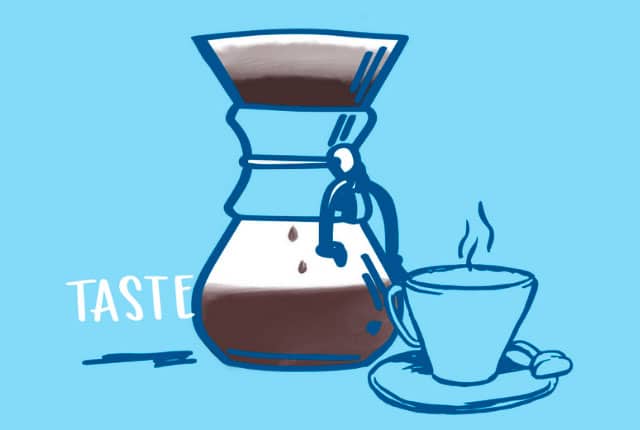
How do minerals influence the taste of coffee ? Do water treatment substances influence the taste of coffee ? Is it possible to taste organic substances in coffee ?
Sponsored content provided by BRITA
Water is an excellent solvent that consists of more than just the pure chemical compound of hydrogen (H) and oxygen (O), i.e. H2O. Substances from the environment and minerals are dissolved in drinking water, and these influence the taste of coffee because they determine the chemical properties and solvent behavior of the water. (1)
Which substances can be dissolved in water?
- Minerals – influence the extraction and can interact with extracted substances
Water without minerals (distilled water) extracts different substances from the coffee grounds to water with lots of minerals. (2)
Whether or not a coffee tastes good depends to a certain extent on the overall mineralization (the sum of all the minerals) and alkalinity (in other words, the carbonate hardness of the water).
The most important minerals occurring naturally in drinking water include calcium, magnesium, sodium, and potassium, as well as chloride, sulfate, and hydrogen carbonate. The latter is responsible for the alkalinity, and together with calcium and magnesium also for the carbonate hardness of the water. This has a strong influence on the development of the coffee’s flavor. (3)
IN MOST NATURAL WATERS, THE CARBONATE HARDNESS IS THE SAME AS THE ALKALINITY. HERE, THE TERMS “ALKALINITY” AND “CARBONATE HARDNESS” CAN BE USED SYNONYMOUSLY.
Hydrogen carbonate in water has a chemical effect as a so-called “buffer.” That means it neutralizes acids. Caffeic acids are a crucial factor in the taste of coffee, however. (4)
Other minerals such as sodium, magnesium, and calcium play a more minor role in terms of the taste of coffee. Certain studies have recently examined this topic, but a theoretically better extraction through a greater proportion of magnesium in the drinking water went unrecognized by 14 testers in a blind taste test (5) (4).
When there is a lot of hydrogen carbonate or the water is too hard, it reacts with the fine caffeic acids. The coffee then tastes unbalanced, bitter and flat. In general, however, there is solid evidence that most people prefer coffee made with soft water. It then has the perfect balance of acidity and bitterness, so that delicate coffee aromas can develop. Coffee associations also recommend soft water with low carbonate hardness for preparing coffee. – Birgit Kohler, Head of Organoleptic Department at BRITA
- Water treatment substances – can interact with extracted substances and become perceptible in the coffee
Certain substances are deliberately added to treat water for example substances to eliminate clouding (turbidity) or chlorine for disinfection. A small quantity of chlorine is added to disinfect tap water. However, chlorine, combined with organic residues can give water an unpleasant odor and unpalatable taste. (6)
Depending on the binding partner, chlorine has different tastes/taste qualities and threshold values. (7) If the water to be used for the coffee already smells of chlorine, it’s very probable that the coffee will also take on a chlorine-like aftertaste. Yet even if chlorine is not perceptible in the water, there can still be reactions with the delicate coffee aromas. These interactions can change the aroma profile of the coffee.

- Organic Substances can be perceptible in the taste of coffee.
Organic substances include plasticizers, residues of plant protection agents and solvents, but also natural substances like algae metabolites. Organic matter in drinking water is highly controlled. Many of these substances, such as pesticides, have very strict limit values.
Some of these substances are perceptible in taste even in tiny quantities. One example is geosmin – a natural algae metabolite – tiny amounts of which can produce an earthy-musty taste reminiscent of beetroot.
Many of these organic contaminants can arise as off-flavors in water as well as coffee. Hence geosmin is also formed in coffee beans when they are incorrectly dried or if they are exposed to excessive moisture in storage. (9)
EVEN WITH HIGH-QUALITY COFFEE BEANS, THE WRONG KIND OF WATER CAN RISE TO UNWANTED TASTES TYPICAL OF COFFEE.

Sources:
- Lide, David R. Handbbook of Chemistry and physics. s.l. : CRC Press, 1998.
- Violoni, M. Water for French press coffee – Big Sensory Test. Bresica : Centro Studi Assaggiatori; Luigi Odello, 2015.
- M. Wellinger, S. Smrke, C. Yeretzian. the SCAE Water Chart. 2015.
- M. Colonna-Dashwood, C. Hendon. Water for Coffee. Bath, United Kingdom : Colonna and Small‘s, 2015.
- The Role of Dissolved Cations in Coffee Extraction. C. Hedon, L. Colonna-Dashwood, M. Colonna-Dashwood. 2014, Journal of Agricultural and Food Chemistry, Bd. 62, S. 4947-4950.
- GmbH, BRITA. Water Basics. 2017.
- Foundation, Awwa Research. Long-Term Effects of Disinfection Changes on Water Quality. s.l. : U.S. Environmental Protection Agency; Awwa Research Foundation; American Water Works Association, 2007.
- https://de.wikipedia.org/wiki/Geruchsschwelle. [Online] [Zitat vom: 19. April 2018.]
- Andrea Illy, Rinantonio Viani, Rinantonio Viani. Espresso Coffee – The Science of Quality. s.l. : elsevier, 2004.
- M. Antonopoulou, E. Evgenidou, D. Lambropoulou, I. Konstantinou. A review on advanced oxidation processes for the removal of taste and odor compounds from aqueous media. water research 53. 2014, S. 2 1 5 – 2 3 4.
- World Health Organization, Guidelines for drinking-water quality – 4th ed. 2011.
Original post made by : https://scanews.coffee/
